As the army of airdrops continues to grow, project parties are becoming more cautious about distributing airdrops, and the popular project Worldcoin in the past two days is no exception.
Although top-tier exchanges such as OKX and Binance have announced plans to list its token $WLD, as a project that aims to distribute airdrops to all of humanity, Worldcoin faces a more arduous witch prevention task, which has led to much controversy over the iris authentication it employs.
In addition, the recently concluded Linea testnet event also introduced identity authentication to prevent witch attacks. Users who complete identity authentication can receive an additional 2500 points.
It is clear that project parties are taking a stance against witches, and completing account authentication has become a prerequisite for every project participant. This article will introduce several popular projects that focus on identity authentication and witch prevention.
- 5 DeFi Projects Worth Paying Attention to Recently
- Understanding Community Culture from an Awakening Individualism Perspective
- Flashbots Open-source MEV-Share Node
01. World ID
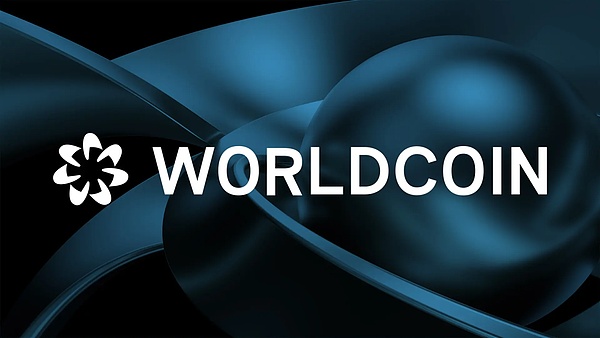
Introduction
Worldcoin is a cryptocurrency project founded by Sam Altman, the founder of OpenAI, in 2020. It aims to use blockchain technology to establish an open-source protocol for global financial fairness and inclusiveness.
With the popularity of ChatGPT, this project from 2020 has gradually gained recognition. However, in June of the same year, Worldcoin secured $25 million in financing with a valuation of $1 billion. The investment lineup was star-studded, including Digital Currency Group, Coinbase Ventures, a16z, Multicoin Capital, as well as LinkedIn founder Reid Hoffman and FTX founder Sam Bankman-Fried.
In late March 2021, Worldcoin secured $100 million in financing with a valuation of $3 billion.
Currently, there are still many people in many countries who do not have legal identities. Worldcoin’s mission is to provide these people with a unique digital identity.
The goal is to create a digital economy that anyone can participate in and ultimately benefit from the decentralized collective ownership.
To achieve this goal, the first step is to ensure that its tokens are used by enough people, so conducting token airdrops is an essential operation.
As mentioned at the beginning of the article, for Worldcoin to carry out such a large-scale airdrop, the witch prevention task it faces is inevitably more arduous, so they have implemented a hardcore authentication method, directly confirming the user’s real identity through iris information.
Worldcoin consists of three parts: tokens, World ID (DID), and World APP (wallet). World ID is used to verify the user’s unique identity and prevent witch attacks, while World APP is used to receive airdrops of $WLD.
Currently, there are many methods for real identity verification, such as face, fingerprint, and genetics, among others. Worldcoin uses iris verification, focusing on its uniqueness and anti-fraud capabilities. In short, it is more difficult to forge iris information.
The promotion and operation of World ID is relatively simple. Worldcoin has launched an iris detection device called Orb. They recruit local agents in various countries and distribute Orbs to these agents after assessment and training. The agents are responsible for completing the iris collection tasks.

The more irises the agents collect, the more rewards they will receive. In addition, each time a user’s iris is collected, they will receive small gifts and token rewards. Therefore, the overall effect of their offline promotion is good.
Due to the strict identity verification requirements and the sensitive nature of collecting users’ biometric information, many countries’ laws prohibit organizations from collecting users’ biometric information without permission and taking these information out of the country.
Therefore, the biggest obstacles to iris authentication at present are the number of Orbs and compliance restrictions of sovereign countries.
Worldcoin plans to increase the number of Orbs to 1500 units in the summer and autumn of this year, and will also launch World ID in more countries and regions, such as the United States, Mexico, Hong Kong, China, Japan, Singapore, and so on.
Projects currently using World ID:
-
Worldcoin: https://twitter.com/worldcoin
-
Web3 social graph Lens Protocol: https://human.withlens.app/
Operation
Since the certification of World ID requires the collaboration of Orb for iris collection, if your country or region is not within the support range of Worldcoin, you will still not be able to obtain World ID. Therefore, here we only discuss the operational part and the basic principles of certification.
First, users need to download their wallet World APP, which is currently available on major app stores.
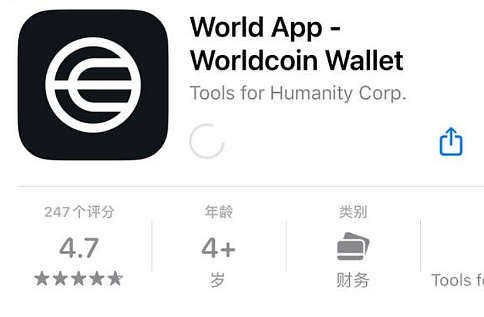
After installing the wallet, you will be asked to choose whether to create a new wallet or import an existing one. When creating a new wallet, you will also be asked to verify the mobile phone number. Of course, you can choose to skip and verify it later.
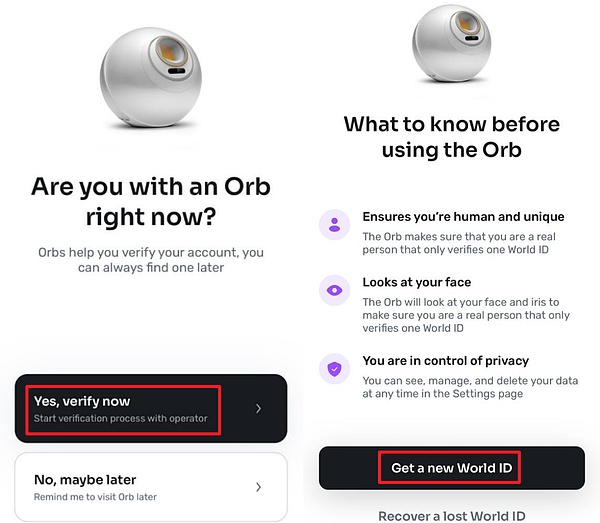
If you verify immediately, you need to turn off VPN. After verification, you will receive 25 $WLD tokens.
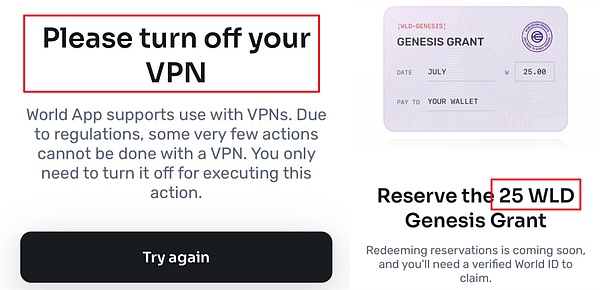
The basic principle of verification is as follows: when creating a new wallet, you will obtain a key pair, including a private key and a public key. The user provides the public key to the iris detection device Orb for detection. Orb will calculate an IrisHash unique identifier based on the collected iris image through an algorithm.
When the IrisHash is not in the database, it means that the user is registering for the first time. Only through such verification can the user successfully register a new World ID.
02. Gitcoin LianGuaissport
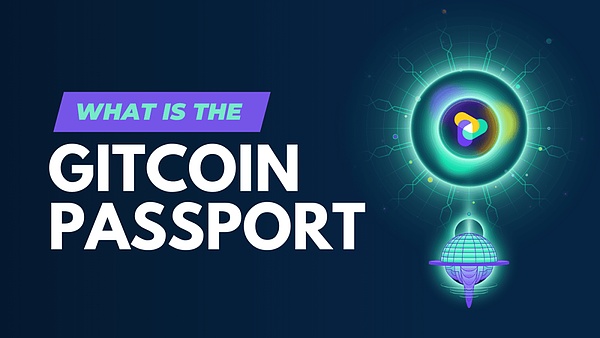
Introduction
Gitcoin LianGuaissport is probably the most well-known identity verification system. Gitcoin is an open-source donation project based on Ethereum. Its main purpose is to help raise funds for open-source projects and build a bridge between projects and users.
Gitcoin was founded in 2017 by American engineer and entrepreneur Kevin Owocki. In April 2021, it received $11.3 million in financing from LianGuairadigm, and in November of the same year, it received $500,000 raised by the Ethereum Foundation.
As a donation platform, Gitcoin has raised early funding for many excellent projects, and these projects have also distributed airdrops to donating users, such as GTC, ENS, BrightID, and so on.
Due to the ease of obtaining project airdrops through donations, there were a large number of users who donated for the sole purpose of receiving airdrops, leading to the emergence of Gitcoin LianGuaissport.
Gitcoin LianGuaissport is a Web3 identity verification aggregator designed to prevent witch attacks. It can collect verifiable credentials to prove user identity and credibility while protecting user privacy.
In Gitcoin’s own quadratic funding mechanism, there is a concept of matching donations. When a user makes a donation, Gitcoin’s funding pool will also match a portion of the funds to the project based on the number of donors for that project.
However, only Gitcoin LianGuaissport with a score exceeding 21.76 can qualify for matching donations.
As Gitcoin’s influence grows, its LianGuaissport is gradually being accepted by other project parties, such as the new public chain Linea mentioned above.
In the future, it is highly likely that the operations of some projects will require Gitcoin LianGuaissport scores as a threshold. As users, it is necessary for us to complete the corresponding authentication tasks.
Projects that adopt Gitcoin LianGuaissport:
-
Donation platform Gitcoin: https://twitter.com/gitcoin
-
Layer 2 public chain Linea: https://twitter.com/LineaBuild
-
Layer 2 public chain Taiko: https://twitter.com/taikoxyz
-
Decentralized social graph protocol CyberConnect: https://twitter.com/CyberConnectHQ
-
Currency exchange platform ShapeShift: https://twitter.com/ShapeShift
-
First DEX on Linea EchoDEX: https://twitter.com/Echo_DEX
Operation:
https://passport.gitcoin.co
The overall operation of Gitcoin LianGuaissport is relatively simple, just open their official website to see all the tasks clearly.
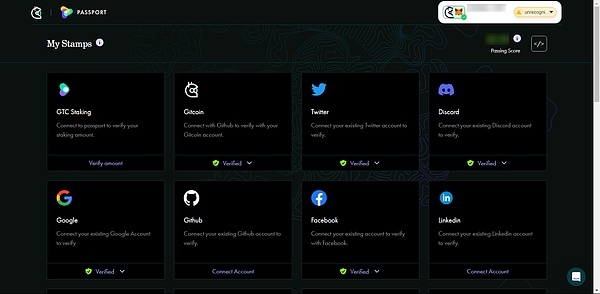
After completing each task, you will be given corresponding scores, such as binding Google account, Facebook account, Discord account, etc.
Based on the completion of these tasks, Gitcoin gives an overall score of authenticity to the user. The higher the score, the more trustworthy your wallet address is considered.
If other projects adopt Gitcoin LianGuaissport scores, then the higher your score is when interacting with these projects, the lower the probability of being considered a witch.
For the specific scores corresponding to each task and the strategy to achieve a score of 20 or above at the lowest cost, you can refer to the mind map and strategy previously released by Biteye.
“One picture teaches you how to save money quickly and improve your Gitcoin LianGuaissport score” https://twitter.com/BiteyeCN/status/1673273955560599554?s=20
“The latest verification strategy for Gitcoin LianGuaissport” https://mirror.xyz/0x30bF18409211FB048b8Abf44c27052c93cF329F2/J8KayQG2NOj-OZ_EMSgfHl3_cln1lCuUTNQuA_hOAcw
03. Nomis
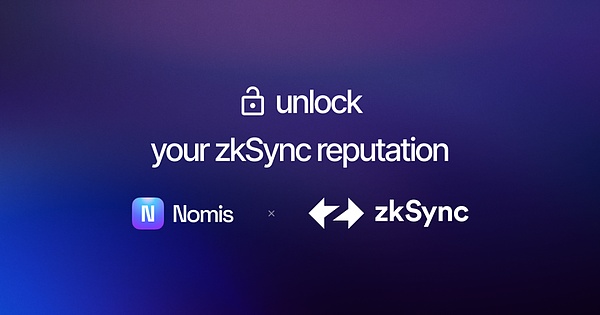
Introduction
Nomis is a reputational project that suddenly became popular a few days ago. It is launched by the Web3 credential data network Galxe and aims to establish an open Web3 on-chain data reputation system using the transparency of blockchain.
In airdrop activities, witch users often profit in various ways, causing great trouble to project parties and community members.
Although blockchain has its own transparency, it can see these witch users transferring the same amount of tokens between multiple wallets. But without suitable tools, this information is useless.
As such a tool, Nomis uses a custom wallet scoring model to assess the eligibility for airdrops of addresses. The score is based on more than 30 parameters and takes into account different types of wallet activities.
With this model, project parties can customize parameters and weights to calculate users’ scores. Once a user’s score falls below a certain level, they can be clearly marked as a witch.
Nomis always believes that even if the owner of a wallet is not a witch, using tools like Nomis can greatly reduce the workload of manual review.
Similarly, although it is impossible to change the minds of witch users, at least their operations can be invalidated, which is what Nomis wants to do.
The reason why this project became popular is related to the popular Layer 2 public chain zkSync. Just when everyone was interacting with zkSync, zkSync suddenly retweeted Nomis’s tweet, causing panic and many people started to worry that zkSync would also start cracking down on witch accounts.
Nomis also released related articles, stating that they are the first identity protocol deployed on zkSync, which is of great significance to them.
Instead of worrying about project parties starting to catch witches, it is better to be prepared in advance and improve your score, which is a wiser choice.
Projects that adopt Nomis:
-
Web3 credential data network Galxe https://twitter.com/Galxe
-
Layer 2 public chain zkSync https://twitter.com/zksync
https://nomis.cc/multichain
Open the official website and you can see the comprehensive score of our bound wallet on the left. Users with a score of more than 40 can mint the Score SBT on the right. This SBT costs money. In other words, a score of 40 is a passing score.

If you want to improve your score here, you can see the parts that make up the score. You can see it under Stats below the score.
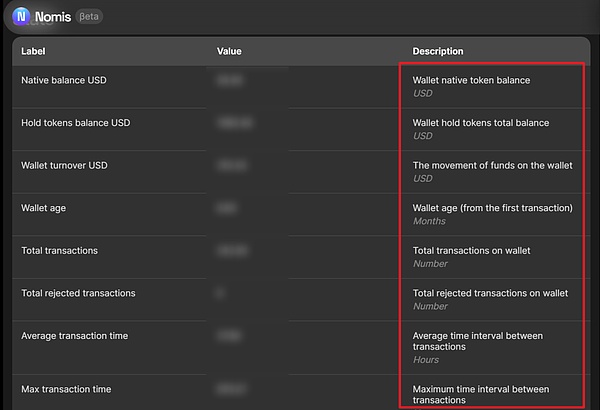
According to the description on the right, we can basically summarize the following operations to improve scores:
-
Increase wallet funds
-
Increase transaction volume
-
Increase transaction frequency
-
Increase wallet NFT quantity
-
Increase the total value of NFT
https://mirror.xyz/0xnomis.eth/ne_vvBn04A0OmInI2ssirP4iMCwb_E0jNZcV8znQ9go
In addition to some operations of the project itself, the article mentioned above, which was published by the official on Mirror when zkSync was launched, can also be minted as a commemorative moment. Optimism’s fees are very cheap, about 0.1U, and currently only 28 people have minted it.
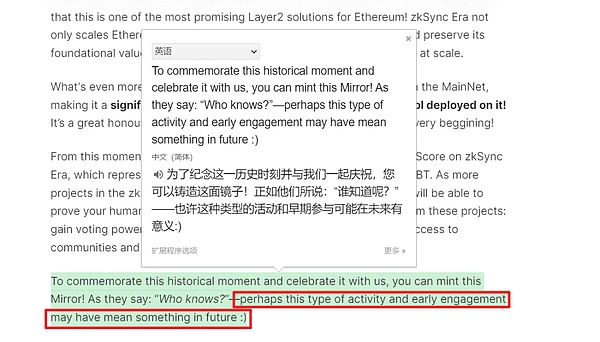
04. Degenscore

Introduction
Degenscore is a decentralized identity system based on on-chain behavior. Unlike Nomis mentioned above, Degenscore supports multiple chains, and all scores of Degenscore are composed of behaviors on the Ethereum mainnet.
Users with scores over 700 can mint a Degenscore Beacon SBT, but it is not easy to reach 700 points.
Although the difficulty is relatively high, once certified by Degenscore, there are still many benefits.
Many projects will cooperate with Degenscore, providing whitelist benefits to users, and the most well-known one is the whitelist of Lens, which was worth about 270U at its peak.
Projects adopting Degenscore:
-
Web3 social graph Lens Protocol https://twitter.com/LensProtocol
-
Web3 social APP based on Lens Phaver https://twitter.com/phaverapp
-
Cross-chain bridge Via Protocol https://twitter.com/via_protocol
-
On-chain identity visualization project PHI https://twitter.com/phi_xyz
-
Wallet project XDEFI Wallet https://twitter.com/xdefi_wallet
And more…
Degenscore has many cooperative projects, which can be viewed on the official website. The projects listed in Cafe basically adopt Degenscore.
Operation
https://degenscore.com
When you open Degenscore’s official website, the Cafe interface appears. It includes Opportunities, Abilities, and Jobs, which directly tell users the benefits of holding Beacon.
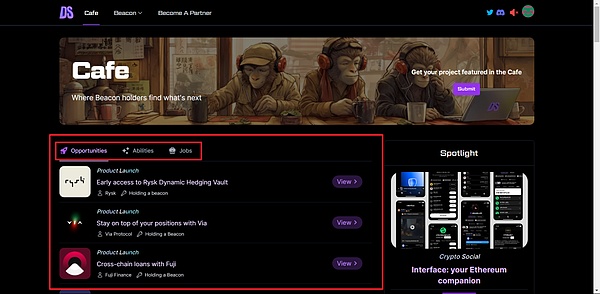
-
Opportunities: Beacon holders can experience the beta features of these cooperative projects in advance
-
Abilities: Beacon holders have special rights in cooperative projects
-
Jobs: Beacon holders can get priority job opportunities in recommended projects and companies
Click on Beacon in the menu bar above, select Overview, and you can see the application interface. The minting process is simple, the only requirement is that the address must exceed 700 points.
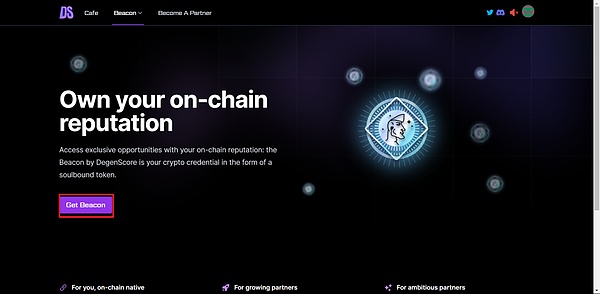
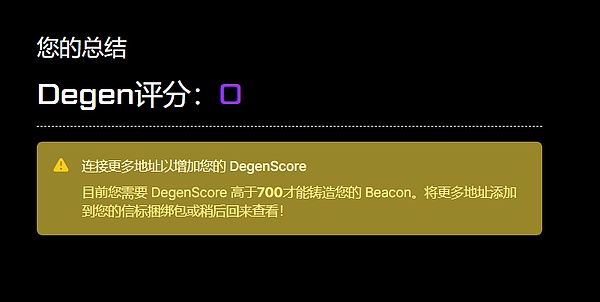
Improving the score is simple, just go to the Leadrboard under the Beacon in the top menu bar, and interact with the projects that the top 100 high-scoring users have interacted with.
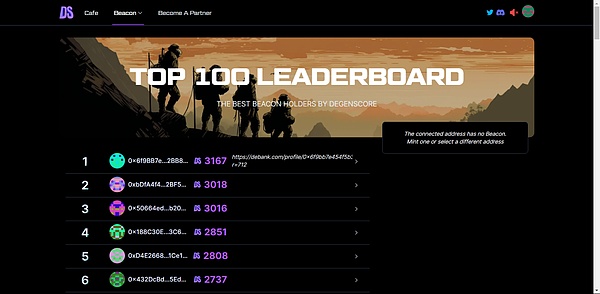
Since it is operated on the mainnet, users need to prepare more ETH as GAS.
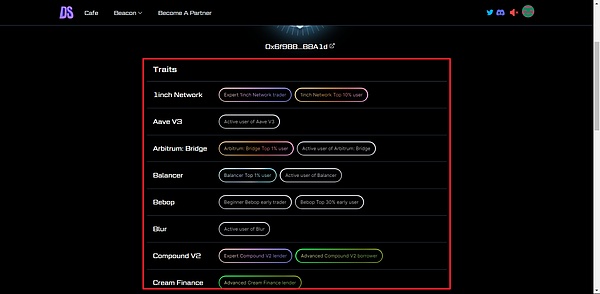
05.Sismo
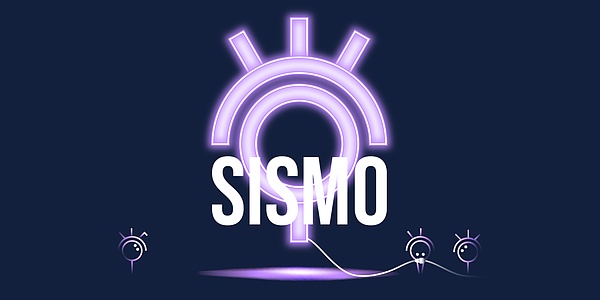
Introduction
Sismo is an on-chain reputation project based on zero-knowledge proofs. It is said to be a project started by a former employee of Aave and completed a $10 million financing in December 2021.
The investment lineup is quite strong, including Framework Ventures, Delphi Digital, Fabric Ventures, Global Coin Research, Seed Club Ventures, and others.
One of its major features is that users can prove ownership of certain assets without disclosing their wallet addresses.
This is very attractive to users who want to demonstrate their strength but are afraid of privacy leaks. For example, Ethereum founder Vitalik has mentioned in his blog that he is very optimistic about the identity ecosystem and gives examples. Sismo is one of the projects he specifically mentioned.
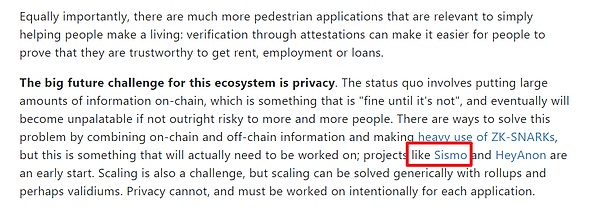
(Vitalik’s blog, https://vitalik.eth.limo/general/2022/12/05/excited.html)
So how does Sismo solve this problem? Many users in the crypto world don’t have just one wallet. For example, one wallet owns 100 ETH and another wallet owns 100 UNI. When I participate in the corresponding meeting, I need to provide proof of assets twice.
There are two problems here. One is that I need to disclose both of my addresses, which compromises privacy. The other is that I need to provide proof of assets twice, which is cumbersome.
In Sismo’s official introduction, the concept of single sign-on is mentioned. It means that users only need to log in once, and other places can be directly verified without logging in. For example, once you log in to your Google account, Gmail, Youtube, Google Translate, Google Docs, and so on will automatically log in without requiring users to enter the account password multiple times.
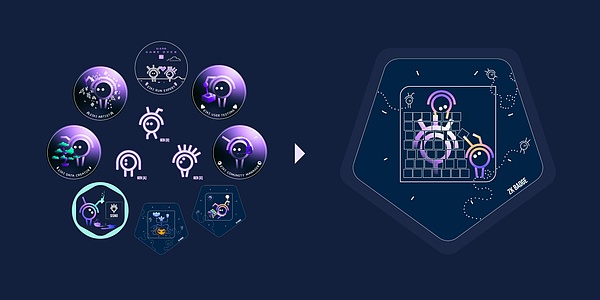
Sismo’s badge serves this purpose. Users only need to go through the verification process once to generate a badge, which can be sent to a new address that does not have any assets.
In this way, even if the new address does not have the asset, with this badge, you can still prove your on-chain identity. And since all badges are on one address, users do not need to use multiple wallets for multiple verifications.
Projects that adopt Sismo:
Web3 privacy layer Aztechttps://twitter.com/aztecnetwork
Multi-chain DeFi aggregator rhinofi https://twitter.com/rhinofi
Operation
The operation of Sismo is currently to obtain badges. There are two main types of badges, official badges and badges issued by third parties, such as badges that can be claimed by users who donate to G15. https://app.sismo.io/
Open the link above, the first thing you see is the G15 badge. If you can’t find it, you can search for keywords in the search box on the left.
(Note: The website app.sismo.io may become invalid in the future, you can use apps.sismo.io instead.)

Enter the badge details page and claim it directly. If your wallet does not meet the requirements, you will be asked to switch to another wallet.
Currently, many badges have time limits and there are relatively few badges that can be claimed. After the update, Sismo also provides the function to create badges.
Open the website below and click “Create a Data Group” to create your own badge, although such self-created badges may not have much weight, but treat it as an experience project. https://factory.sismo.io/
06. Summary
The mentioned projects are just some of the more popular and noteworthy projects in the identity verification field. There are still many other similar projects:
-
Binance Account Bound (BAB): Identity verification for Binance wallet accounts, complete KYC to qualify, a threshold for Binance-related projects
-
Galxe LianGuaissport: A passport launched by Galxe, complete KYC to qualify, a threshold for some projects on Galxe
-
Debank: A multi-chain DeFi wallet that recently launched the badge function and has its own WEB3 ID, but requires a payment of $96
Regarding the five projects mentioned above, the summary is as follows:
1. World ID currently faces the biggest controversy. From the perspective of anti-witch, its iris authentication can filter out the majority of witches, and even because the verification is too difficult, some real users are filtered out.
However, the collection of users’ biometric information is a very sensitive operation. Although Worldcoin claims that it will not store users’ iris images and will delete these images once the algorithm is optimized, we do not know when it will be optimized and whether there will be leaks during the collection process by local agents.
At the same time, due to the limited number of Orbs, the efficiency of this off-chain verification is far lower than that of on-chain verification. Therefore, whether World ID is a reliable, effective, and secure identity authentication tool still needs to be verified.
2. The most widely used should be Gitcoin LianGuaissport. It uses a large number of tasks to verify users’ identities, including both on-chain and off-chain tasks. The evaluation of user identity is relatively comprehensive and reliable.
In the future, many projects are likely to adopt its verification as a tool to filter out witches. For users who want to receive airdrops, they should pay more attention to and improve their scores on Gitcoin LianGuaissport.
3. The easiest and most cost-effective operation is undoubtedly Nomis. Users do not need to complete various tasks, but only need to perform more operations, save more money, and buy more NFTs on the chain to improve their comprehensive score.
Moreover, it is a multi-chain comprehensive score, and you can perform operations on layer 2 chains, which not only saves money but also provides a more diverse evaluation of users.
4. The most difficult and costly operation should be Degenscore. Not only are there many tasks, but they also need to be operated on the mainnet, and users may need to prepare a considerable amount of fees to support the interaction, which is costly.
Although the size of funds can to some extent determine the authenticity of an address, for a project, the premise of filtering out real users is authenticity, not just the amount of funds.
Using Degenscore as a tool for witch judging will result in serious distortion. In my opinion, Degenscore is more like a rich people’s club, or as its name suggests, a Degen (experienced, heavy user) club, so ordinary users don’t need to be too obsessed with their score.
5. The last one is Sismo, which uses zero-knowledge proof and focuses on privacy protection as its advantage. However, Sismo is still in the relatively early stage, with few cooperative projects and changing technical routes, so there won’t be many things that users can experience. For now, you can try to collect badges or use its badge creation function, and keep an eye on its latest developments at any time.
Like what you're reading? Subscribe to our top stories.
We will continue to update Gambling Chain; if you have any questions or suggestions, please contact us!